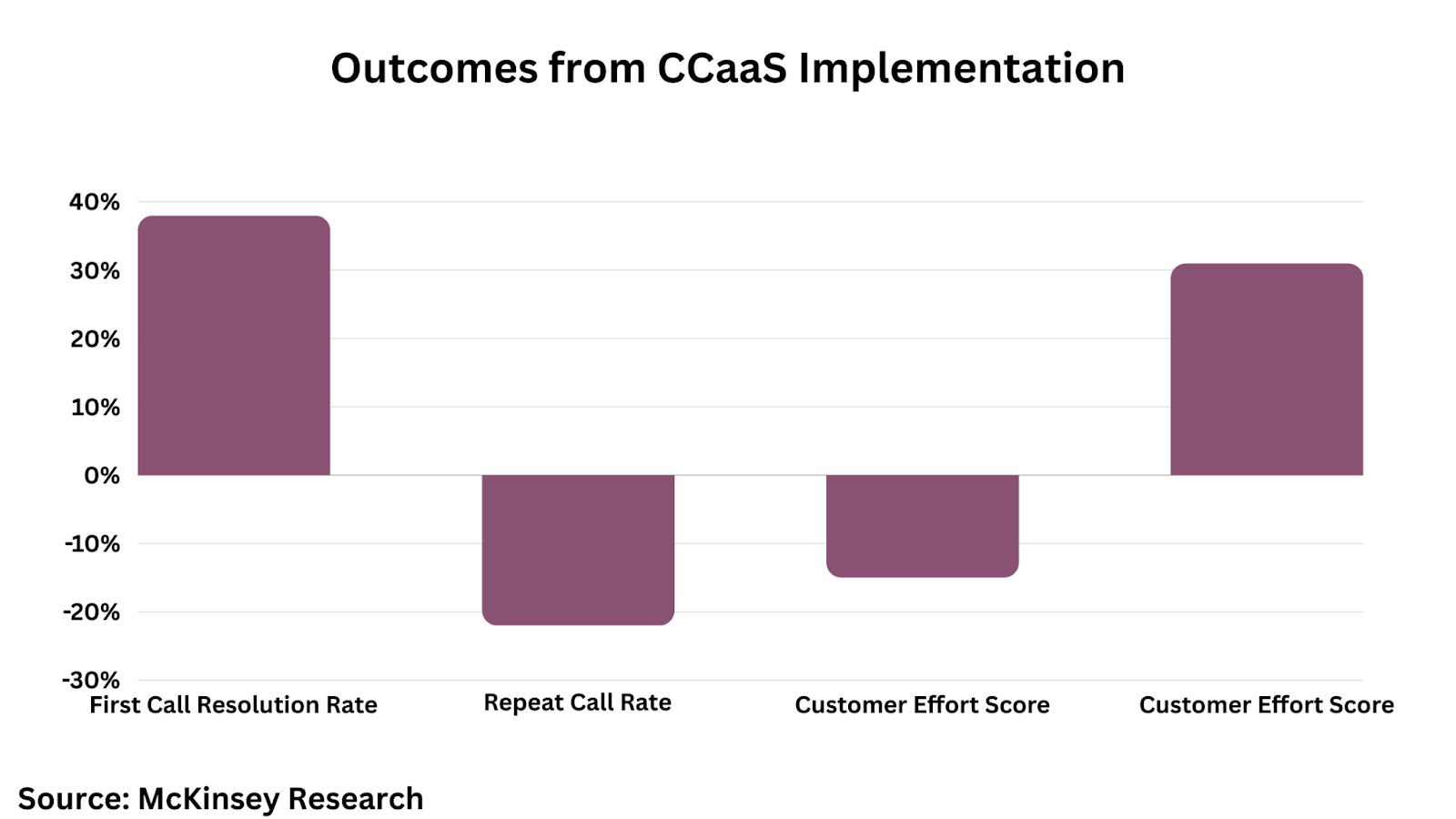Digital transformation has revolutionized customer service, evolving consumer expectations. Customers today demand personalized, efficient interactions across multiple channels.
For businesses, meeting these rising expectations at scale poses an immense challenge. That’s where a Contact Center as a Service (CCaaS) helps. CCaaS solutions provide the necessary agility and capabilities. This makes a seamless, omnichannel customer experience possible.
The Rise of CCaaS Vendors
Advancements in cloud technology have enabled the rapid emergence of the best CCaaS vendors. In 2023, the CCaaS market experienced a 25% growth rate. This shows that businesses wanted smarter customer engagement solutions. What’s fueling this surge? Let’s examine the contributing factors.
- Flexibility and Scalability
Legacy on-premise contact center infrastructure can’t adjust quickly to fluctuations in workload. CCaaS platforms leverage the cloud for easy scalability. This enables businesses to dynamically manage changing capacity needs. Flexibility and scalability can be easily provided by CCaaS vendors
- Latest Technologies
CCaaS provides access to cutting-edge innovations. These innovations include AI chatbots and advanced analytics. They help drive efficiencies and improve contextual interactions. On-premise systems lag behind in delivering such capabilities.
- Lower Total Cost of Ownership
CCaaS does away with large upfront investments needed for on-premise infrastructure. The pay-as-you-go model translates into a 40% lower total cost of ownership compared to legacy setups.
Key Features of CCaaS Platforms
Modern CCaaS platforms offer a robust suite of capabilities:
- Omnichannel Support
Businesses can communicate with customers through social media, and web chats using this feature.
Agents can manage interactions from a single interface with an integrated dashboard. This lets them handle communications on different channels easily. This is made possible because a CCaaS platform also serves as omnichannel software.
- Workforce Optimization
CCaaS platforms offer a range of tools and capabilities to optimize the performance of human agents. Intelligent routing algorithms ensure that incoming inquiries are directed to suitable agents. This is based on factors such as skill level, availability, and customer priority.
Performance analytics tools help managers understand agent productivity. They show where improvements are needed. Managers can then give focused coaching and training. This significantly advances your business. This makes you understand how to spell business and move it to the next level.
It also incorporates smart automation for basic tasks. This helps agents focus on harder and more important interactions.
- Integrations
CCaaS platforms easily integrate with many business systems and applications. These include CRM, HR, omnichannel call center software, and financial software.
This integration lets different systems share data. Agents can see all customer information and interactions in one place.
Agents can view customer profiles, purchase history, and past interactions by connecting to CRM systems. This helps agents offer personalized support. Connecting with HR systems helps manage workforce tasks. These tasks include scheduling, training, and evaluating performance.
- Security
CCaaS platforms prioritize security. This is because of the sensitive customer data they handle and the potential harm from security breaches. The top CCaaS platforms use strong security measures to prevent unauthorized access and data breaches.
CCaaS platforms use access controls, and encryption protocols to keep customer data safe. Businesses can trust that their data is secure when they follow industry standards and best practices.
- Scalability
CCaaS platforms offer scalability to accommodate fluctuations in contact center demand. These platforms can handle more calls during busy times and fewer calls during slow times. They can adjust capacity as needed.
Businesses with changing customer activity or sudden demand spikes from marketing need scalability. A scalable CCaaS solution helps businesses allocate resources efficiently. This helps to meet changing needs without costly investments or downtime.
- Real-time Monitoring
Businesses can track key metrics and performance indicators instantly with real-time monitoring. This helps them understand contact center operations better.
Managers can track agent activity, queue lengths, service levels, and other key metrics. They can do this through dashboards and alerts that they can customize. This allows them to spot issues early and take action. Real-time monitoring helps managers assign staff and adjust workflows based on current conditions. This improves operational efficiency, service quality, and customer satisfaction.
- Inbuilt Latest Technologies
CCaaS platforms bring the latest tech to enhance efficiency, insights, and personalized interactions.
- AI and Machine Learning: Smart chatbots handle basic queries, freeing up agents. Sentiment analysis understands customer feelings for better responses. Machine learning keeps improving accuracy.
- Workforce Engagement: Games and dashboards motivate staff. Recommendation systems help agents with faster issue resolution.
- Emerging Channels: Easily add new channels like mobile messaging and video chat. This can be done without infrastructure issues.
Comparison of key advantages of CCaaS platforms over legacy on-premise contact center infrastructure
| Capability | CCaaS | Legacy On-Premise |
| Omnichannel customer support software | Yes | Limited |
| Rapid Scalability | Cloud-enabled | Constrained |
| Latest Innovations | Continuous delivery | Lagging updates |
| Lower TCO | Up to 40% lower | Higher investment |
The Impact: Transforming Customer Experiences

Here’s how CCaaS transforms customer experiences:
- Enhanced Service Quality
- Improved CSAT Scores: Companies report up to a 45% increase. This increase is driven by faster response times and personalized interactions that are tailored to the context.
- First Call Resolutions: This increased by more than 35%. This was done through agents using knowledge, and giving proactive service recommendations.
- Self-Service Rates Increase by 33%: AI helps people use self-service more. The interfaces are user-friendly. The journeys are customer-focused.
- Boosted Operational Efficiency
Management decreased costs by over 60% using CCaaS tools to predict workloads. They also used it to allocate resources efficiently and analyze bottlenecks. Smart routing and automation improved workforce utilization by up to 8 points. They managed repetitive tasks.
30-50 Decline in training time using micro-learning apps, gamification, and AI-guided coaching. Onboarding time also shrinks dramatically.
Modern brands use CCaaS for big changes and to keep up with customer needs. Big companies like Nike, Disney, Progressive Insurance, and Clifford Chance have worked with CCaaS providers for a long time.
The Road Ahead: Key CCaaS Trends
Here are some key trends to look out for in CCaaS:
- Human + Machine: AI in customer service and CCaaS will manage repetitive requests. Human agents will handle complex issues. This approach combines the strengths of both AI and human agents.
- Asynchronous Engagements: Customers can have conversations at their convenience. This will be done by using digital channels more frequently. They can have these conversations over multiple sessions.
- Predictive Customer Service: Data will be used to predict customer needs. It will also be used to prevent problems and take proactive service steps.
- Focus on Privacy: Privacy will be a big focus, with regulations like GDPR pushing for the secure and ethical use of customer data.
Challenges and Considerations for Adoption
While promising, CCaaS adoption does come with a few change management considerations:
- Integrating Systems: It’s crucial to sync CCaaS with current tools to streamline customer data and workflows. APIs and expert support can simplify this.
- Training Employees: Alignment of agents and leadership with the new solutions is essential. CCaaS providers offer specific training programs for this purpose.
- Maintaining Human Touch: Even with technology, human interaction remains crucial for customer experience. Training and redesigning organizational structures can help uphold personalization.
- Compliance Factors: Vendors now control data. It is necessary to evaluate if they comply with security, privacy, and regulatory requirements.
Choosing the Right CCaaS Partner
There are many vendors that offer CCaaS platforms. To choose the best one for your business, you need to carefully assess:
- Feature set and scalability requirements
- Technology roadmap and commitment to innovation
- Implementation support and customer success track record
- Security, compliance, and global data center presence
- Pricing model suitability
Industry-specific expertise also plays a key role in creating true business value.
Conclusion
Customer service is undoubtedly undergoing rapid digitization. Businesses need to prepare for the changing consumer behavior. This is caused by shifts in demographics and technology.
In this landscape, CCaaS presents a unique opportunity to not just keep pace but get ahead. The true impact is in using CCaaS to shift focus from maintaining to improving customer experience. This helps teams improve service quality now and get ready for the future.
FAQs
- How is CCaaS different from typical contact center solutions?
CCaaS uses cloud delivery to be more flexible, scalable, and quickly access new innovations such as AI. Legacy on-premise models have limited capabilities. They are not easily scalable and require significant upfront investments in infrastructure.
- Can small businesses benefit from CCaaS, or is it suitable only for large enterprises?
The scalability and pay-as-you-go economics of CCaaS make it suitable for businesses of all sizes. Small businesses can use CCaaS to provide high-quality customer service like larger companies.
- What are the key considerations around migrating to CCaaS?
Selecting the best vendor that meets your needs is crucial. To have a smooth transition, it is important to plan how to integrate. Train staff effectively, and reengineer processes to fully utilize CCaaS. Gradual transitions and expert assistance ease the changeover.




